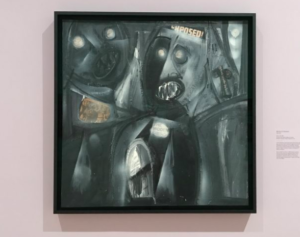Expressionism was a movement that emerged in Germany during the early 20th century. It began as a defiant response to the conventional artistic Impressionist technique, where the depiction of reality was an objective one. Expressionist artists sought out to portray the world through a subjective reality, where their work depicted an emotional experience rather than the mere impression of one. They accomplished this through distortion and exaggeration of objects and events. The arrival of Expressionism announced new standards in the creation and judgment of art; “Art was now meant to come forth from within the artist, rather than from a depiction of the external visual world,” meaning the emotion within the artist was the most important material needed for their piece (The Art Story). As time progressed so did expressionism. Around the late 1940s, another movement called abstract expressionism emerged in New York. Within abstract expressionism were two broad groups: the action painters, who struck their canvases with powerful brush strokes; and the color field painters who were monochromatic painters. The abstract expressionists derived not only from expressionism but surrealism as well. Influenced by the emotion, “Abstract Expressionist painters rejected representational forms, seeking an art that communicated on a monumental scale the artist’s inner state in a universal visual language” (Khan). Following abstract expressionism came neo-expressionism during the late 1970s. This movement also rejected the standard composition and design and communicated a sense of inner disturbance, tension, and alienation. It was characterized as having expressive brush strokes, highly textured painting with paint built up on the canvas’s surface, and intense colors and most importantly always being focused on the controversial. Each of these movements gave many artists the freedom to express their reactions and emotions and allowed them to present the world from a subjective perspective enabling them to further create styles in which they can be more inventive and abrupt toward social injustices.

One of the many artists who was influenced by the expressionist movement was the abstract expressionist painter, Merton D. Simpson. In 1965 he created U.S.A. ’65, a piece in which he used newspapers that negatively portrayed African Americans and incorporated them into his work. The reason that I chose Simpson’s piece was due to his dark and monstrous faces. As an abstract expressionist, your emotions regarding a particular subject must be the main attraction and as for Simpson’s U.S.A. ’65, his emotions regarding the subject are very clear. Not just in the sense of his colors but his overall message of struggle and turmoil shines in his piece.

Faith Ringgold is another abstract expressionist painter who documented social discrimination. In her piece American People Series #20: Die we can see different races and both genders trying to kill each other, however, we can see that she dressed everyone the same. In doing so she shows the viewer, “an abstraction about what the fights were really all about… fighting to retain their position in society,” everyone is dressed equally to show they are all on the same level but there will also always be people who won’t let that happen. Through this style of art, Ringgold was able to speak up and tell the viewer a story and not be limited by anything (MoMA). This not only shows the reader what she physically sees but how she felt as she watches undocumented riots like these happen. American People Series #20: Die is a perfect example of the influence abstract expressionism can have on social movements.

The last artist is Neo-expressionist, Romare Bearden. In his college called The Dove Romare uses various pictures from magazines, newspapers, and photographs to create something, unlike the previous two artworks. His use of all these elements are arranged in a way that the viewer’s eye is constantly on the move, jumping from light areas to dark areas and from pattern to pattern. In a time when society was divided Romare found a way to use his art to bring people together, figuratively and by literally placing people he found from different parts of the word in his artwork. At first glance, it may not seem as though it flows as well as the other paintings but that’s the beauty of Neo-expressionism, it wasn’t meant to follow conventional standards even within the expressionist movement.
Expressionism was a way for artists to convey more than a simple impression of a subject. This movement challenged them to dig deep within themselves and express their emotions, which in its self can be one of the hardest things to do. Expressionism provided artists with the tools they needed to speak up about social issues and along with their distorted images, helped evoke emotions and ideas within others.
Bibliography

